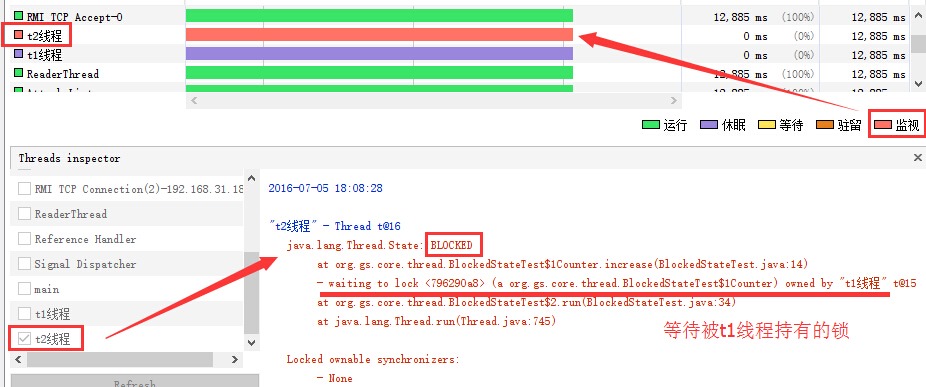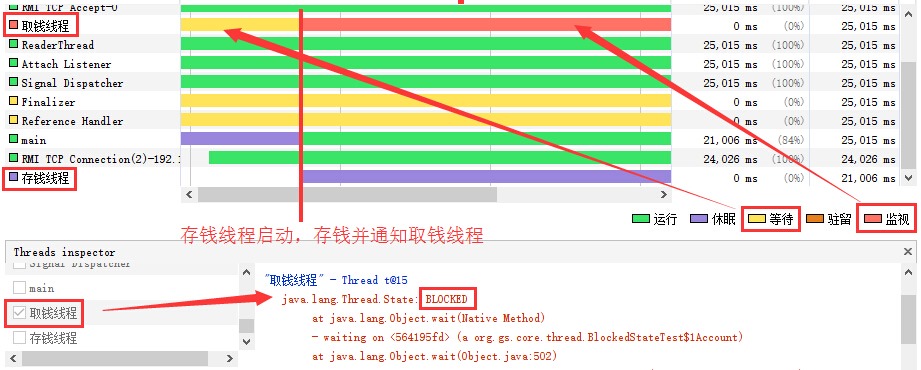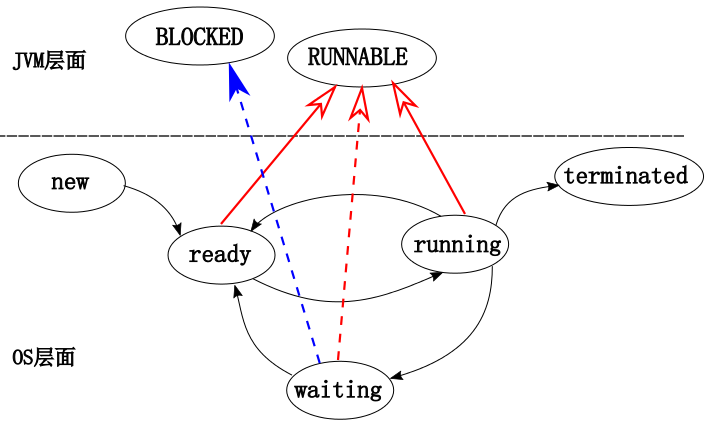Java thread status BLOCKED
Definition of BLOCKED state
As mentioned before, the simple definition of BLOCKED is:
A thread that is blocked waiting for a monitor lock is in this state. (A thread that is blocked waiting for a monitor lock is in this state.)
For a more detailed definition, please refer to the javadoc in Thread.State:
/**
* Thread state for a thread blocked waiting for a monitor lock.
* A thread in the blocked state is waiting for a monitor lock
* to enter a synchronized block/method or
* reenter a synchronized block/method after calling
* {@link Object#wait() Object.wait}.
*/
BLOCKED,This sentence is very long and can be broken into two simple sentences to understand .
A thread in the blocked state is waiting for a monitor lock to enter a synchronized block/method.
A thread in blocked state is waiting for a monitor lock to enter a synchronized block or method.
A thread in the blocked state is waiting for a monitor lock to reenter a synchronized block/method after calling Object.wait.
A thread in the blocked state is waiting for a monitor lock after it calls the Object.wait method to re-enter a synchronized block or method.
Blocked when entering (enter) synchronization block
Let me talk about the first sentence first, this is easier to understand.
Monitor lock is used for synchronous access to achieve mutual exclusion between multiple threads. So once a thread acquires the lock and enters the synchronized block, before it comes out, if other threads want to enter, they will be blocked outside the synchronized block because they cannot obtain the lock. At this time, the state is BLOCKED.
Note: The entry and exit of this state are not under our control. When the lock is available, the thread will recover from the blocking state.
We can use some code to demonstrate this process:
@Test
public void testBlocked() throws Exception {
class Counter {
int counter;
public synchronized void increase() {
counter++;
try {
Thread.sleep(30000);
} catch (InterruptedException e) {
throw new RuntimeException(e);
}
}
}
Counter c = new Counter();
Thread t1 = new Thread(new Runnable() {
public void run() {
c.increase();
}
}, "t1线程");
t1.start();
Thread t2 = new Thread(new Runnable() {
public void run() {
c.increase();
}
}, "t2线程");
t2.start();
Thread.sleep(100); // 确保 t2 run已经得到执行
assertThat(t2.getState()).isEqualTo(Thread.State.BLOCKED);
}The above defines an access counter counter with a synchronous increase method. The t1 thread enters first and then sleeps in the synchronization block, causing the lock to be delayed. When t2 tries to execute the synchronization method, it is blocked because it cannot obtain the lock.
VisualVM monitoring shows the status of the t2 thread:

The "monitor" status on the picture is the BLOCKED status. You can see that t2 is in the BLOCKED state during t1 sleep.
BLOCKED state can be regarded as a special kind of WAITING, specifically waiting for a lock.
wait blocks when reentering the synchronized block
Now look at the second sentence again:
2. A thread in the blocked state is waiting for a monitor lock to reenter a synchronized block/method after calling Object. wait.
A thread in the blocked state is waiting for a monitor lock after it calls the Object.wait method to re-enter a synchronized block or method.
This sentence is a bit convoluted, and it is not easy to translate into a concise Chinese sentence. It is not easy to understand this sentence without a good understanding of the relevant background of wait. Let’s expand on it a little bit here. Since it is reenter, it means there are two enters. The process is like this:
Call the wait method must be in a synchronized block, that is, you must first acquire the lock and enter the synchronized block. This is the first enter.
After calling wait, the lock will be released and entered into the waiting queue (wait set) of this lock.
After receiving the notify or notifyAll notification from other threads, the waiting thread cannot resume execution immediately because the stop is in the synchronized block and the lock has been released, so it must reacquire the lock before reentering (reenter) Synchronize the block and resume execution from the last wait point. This is the second time to enter, so it is called reenter.
But the lock will not be given to it first. The thread still has to compete with other threads for the lock. This process is actually the same as the enter process, so it may also cause BLOCKED because the lock has been occupied by other threads.
This process is called reenter a synchronized block/method after calling Object.wait.
We also use a piece of code to demonstrate this process:
@Test
public void testReenterBlocked() throws Exception {
class Account {
int amount = 100; // 账户初始100元
public synchronized void deposit(int cash) { // 存钱
amount += cash;
notify();
try {
Thread.sleep(30000); // 通知后却暂时不退出
} catch (InterruptedException e) {
throw new RuntimeException(e);
}
}
public synchronized void withdraw(int cash) { // 取钱
while (cash > amount) {
try {
wait();
} catch (InterruptedException e) {
throw new RuntimeException(e);
}
}
amount -= cash;
}
}
Account account = new Account();
Thread withdrawThread = new Thread(new Runnable() {
public void run() {
account.withdraw(200);
}
}, "取钱线程");
withdrawThread.start();
Thread.sleep(100); // 确保取钱线程已经得到执行
assertThat(withdrawThread.getState()).isEqualTo(Thread.State.WAITING);
Thread depositThread = new Thread(new Runnable() {
public void run() {
account.deposit(100);
}
}, "存钱线程");
Thread.sleep(10000); // 让取钱线程等待一段时间
depositThread.start();
Thread.sleep(300); // 确保取钱线程已经被存钱线程所通知到
assertThat(withdrawThread.getState()).isEqualTo(Thread.State.BLOCKED);
}Brief introduction to the above code scenario:
There is an account object with deposit and withdraw methods, and the initial amount is 100 yuan.
The money withdrawal thread starts first and enters the (enter) synchronization block. It tries to withdraw 200 yuan. When it is found that the money is not enough, wait is called, the lock is released, and the thread hangs (WAITING state).
The deposit thread starts after 10 seconds, deposits money and notifies the withdrawal thread, but then continues to sleep in the synchronization block, resulting in the lock not being released.
After receiving the notification, the money-withdrawing thread exits the WAITING state, but no longer holds the lock. When trying to re-enter the synchronization block to resume execution, the lock has not been released by the money-saving thread, so it is blocked (BLOCKED state) ).
Monitored display:

As shown in the figure, the money withdrawal thread is WAITING first, and is blocked (BLOCKED) after receiving the notification because it cannot obtain the lock.
Summary
Looking at these two sentences together, they have two meanings, but they still mean the same thing. Simply put, it is enter, reenter, or enter. In summary:
When synchronization cannot be entered because the lock cannot be obtained block, the thread is in the BLOCKED state.
If a thread is in the BLOCKED state for a long time, consider whether a deadlock has occurred.
BLOCKED state can be regarded as a special kind of waiting, which is a subdivision of the traditional waiting state:

Since the WAITING state has not been mentioned yet, and the wait method is involved here, the wait is also slightly discussed above. After doing some analysis, in the next chapter, the two states WAITING and TIMED_WAITING will be analyzed in more detail.

Hot AI Tools

Undresser.AI Undress
AI-powered app for creating realistic nude photos

AI Clothes Remover
Online AI tool for removing clothes from photos.

Undress AI Tool
Undress images for free

Clothoff.io
AI clothes remover

Video Face Swap
Swap faces in any video effortlessly with our completely free AI face swap tool!

Hot Article

Hot Tools

Notepad++7.3.1
Easy-to-use and free code editor

SublimeText3 Chinese version
Chinese version, very easy to use

Zend Studio 13.0.1
Powerful PHP integrated development environment

Dreamweaver CS6
Visual web development tools

SublimeText3 Mac version
God-level code editing software (SublimeText3)

Hot Topics
 1677
1677
 14
14
 1431
1431
 52
52
 1334
1334
 25
25
 1280
1280
 29
29
 1257
1257
 24
24
 Composer: Aiding PHP Development Through AI
Apr 29, 2025 am 12:27 AM
Composer: Aiding PHP Development Through AI
Apr 29, 2025 am 12:27 AM
AI can help optimize the use of Composer. Specific methods include: 1. Dependency management optimization: AI analyzes dependencies, recommends the best version combination, and reduces conflicts. 2. Automated code generation: AI generates composer.json files that conform to best practices. 3. Improve code quality: AI detects potential problems, provides optimization suggestions, and improves code quality. These methods are implemented through machine learning and natural language processing technologies to help developers improve efficiency and code quality.
 How to use MySQL functions for data processing and calculation
Apr 29, 2025 pm 04:21 PM
How to use MySQL functions for data processing and calculation
Apr 29, 2025 pm 04:21 PM
MySQL functions can be used for data processing and calculation. 1. Basic usage includes string processing, date calculation and mathematical operations. 2. Advanced usage involves combining multiple functions to implement complex operations. 3. Performance optimization requires avoiding the use of functions in the WHERE clause and using GROUPBY and temporary tables.
 How to configure the character set and collation rules of MySQL
Apr 29, 2025 pm 04:06 PM
How to configure the character set and collation rules of MySQL
Apr 29, 2025 pm 04:06 PM
Methods for configuring character sets and collations in MySQL include: 1. Setting the character sets and collations at the server level: SETNAMES'utf8'; SETCHARACTERSETutf8; SETCOLLATION_CONNECTION='utf8_general_ci'; 2. Create a database that uses specific character sets and collations: CREATEDATABASEexample_dbCHARACTERSETutf8COLLATEutf8_general_ci; 3. Specify character sets and collations when creating a table: CREATETABLEexample_table(idINT
 How to rename a database in MySQL
Apr 29, 2025 pm 04:00 PM
How to rename a database in MySQL
Apr 29, 2025 pm 04:00 PM
Renaming a database in MySQL requires indirect methods. The steps are as follows: 1. Create a new database; 2. Use mysqldump to export the old database; 3. Import the data into the new database; 4. Delete the old database.
 How to implement singleton pattern in C?
Apr 28, 2025 pm 10:03 PM
How to implement singleton pattern in C?
Apr 28, 2025 pm 10:03 PM
Implementing singleton pattern in C can ensure that there is only one instance of the class through static member variables and static member functions. The specific steps include: 1. Use a private constructor and delete the copy constructor and assignment operator to prevent external direct instantiation. 2. Provide a global access point through the static method getInstance to ensure that only one instance is created. 3. For thread safety, double check lock mode can be used. 4. Use smart pointers such as std::shared_ptr to avoid memory leakage. 5. For high-performance requirements, static local variables can be implemented. It should be noted that singleton pattern can lead to abuse of global state, and it is recommended to use it with caution and consider alternatives.
 What role does Java play in the development of IoT (Internet of Things) devices, considering platform independence?
May 03, 2025 am 12:22 AM
What role does Java play in the development of IoT (Internet of Things) devices, considering platform independence?
May 03, 2025 am 12:22 AM
JavaplaysasignificantroleinIoTduetoitsplatformindependence.1)Itallowscodetobewrittenonceandrunonvariousdevices.2)Java'secosystemprovidesusefullibrariesforIoT.3)ItssecurityfeaturesenhanceIoTsystemsafety.However,developersmustaddressmemoryandstartuptim
 What are the advantages of using Java for web applications that need to run on different servers?
May 03, 2025 am 12:13 AM
What are the advantages of using Java for web applications that need to run on different servers?
May 03, 2025 am 12:13 AM
Java is suitable for developing cross-server web applications. 1) Java's "write once, run everywhere" philosophy makes its code run on any platform that supports JVM. 2) Java has a rich ecosystem, including tools such as Spring and Hibernate, to simplify the development process. 3) Java performs excellently in performance and security, providing efficient memory management and strong security guarantees.
 How to set the rotation effect of HTML elements
Apr 30, 2025 pm 02:42 PM
How to set the rotation effect of HTML elements
Apr 30, 2025 pm 02:42 PM
How to set the rotation effect of an element in HTML? It can be achieved using CSS and JavaScript. 1. The transform property of CSS is used for static rotation, such as rotate(45deg). 2. JavaScript can dynamically control rotation, which is implemented by changing the transform attribute.




